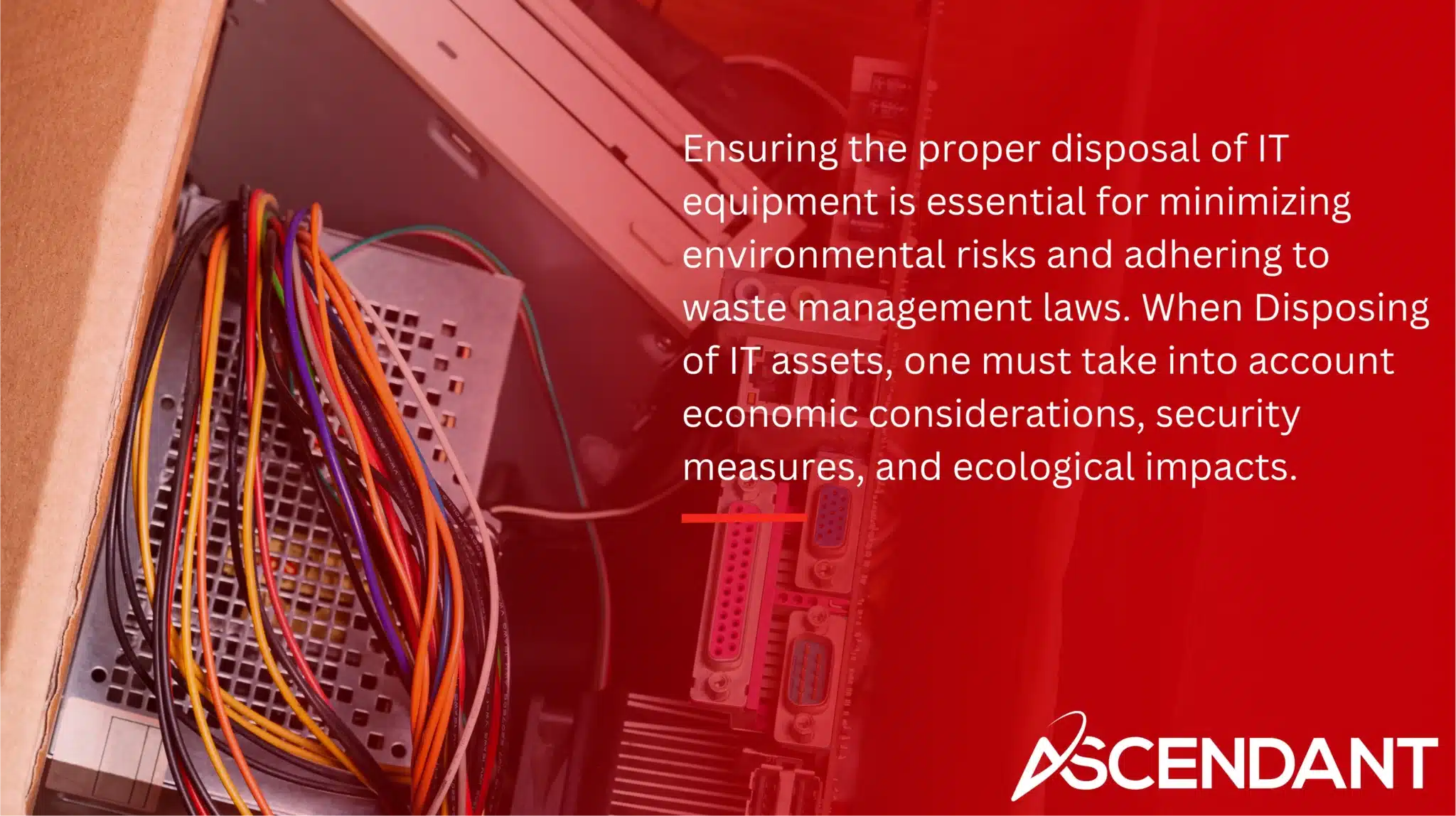Server decommissioning is crucial for data security and compliance. This article explains the steps you need for a successful server decommission: planning, data backup, data wiping, managing licenses, and hardware disposal.
Key Takeaways
- Server decommissioning involves planning, data backup, data wiping, hardware disposal, and updating records to maintain IT security and efficiency.
- A detailed decommissioning checklist and effective scheduling are crucial for a seamless transition and to prevent data loss or security breaches.
- Proper disposal of IT equipment must comply with environmental regulations, and partnering with certified IT asset disposition vendors ensures secure and compliant e-waste management.
Understanding Server Decommissioning
The server decommissioning process is a systematic method to remove obsolete servers and storage equipment from a data center responsibly. This step becomes essential when the hardware has outlived its purpose, needs upgrades, or in instances involving relocations of data centers. The procedure for decommissioning a server goes beyond mere shutdown. It encompasses strategic planning, securing backups of data, erasing information thoroughly from devices, disposing of physical hardware properly and revising records to confirm that no security risks persist.
Understanding the intricacies involved in the server decommissioning process is vital for maintaining your IT landscape’s security while optimizing performance. Correctly executing the process when retiring servers not only addresses potential concerns, but also guards against unauthorized access to sensitive information and helps trim down operational expenses.
Ensuring effective implementation of this procedure stands as an indispensable component within the life span management practices at Data Centers – keeping their infrastructure both current and secure throughout operations.
Planning Your Server Decommissioning Project

Effective planning is key to successful server decommissioning project management. Understanding the process and having a detailed plan helps prevent unforeseen issues and ensures a seamless transition.
Begin by identifying the server for decommissioning and recording all relevant details. Create a comprehensive asset inventory and update asset management systems accordingly.
Next, create a decommissioning schedule and ensure comprehensive backup and data security. These steps will be covered in detail in the following subsections.
Identifying Assets
Initiating the decommissioning process for servers requires a thorough identification and cataloging of all targeted assets. This initial phase necessitates compiling an exhaustive list that captures every server, along with its corresponding equipment specifics, such as physical locations and configuration settings.
Subsequently, it is essential to document each service and application running on those servers while also mapping out their network dependencies comprehensively. By maintaining a detailed record of these elements, you ensure that no vital parts are missed during the decomissioning process, promoting an efficient progression throughout the project.
Creating a Decommissioning Schedule
A timeline for decommissioning tasks ensures that all steps are executed systematically. Outline specific tasks, timelines, and responsible personnel to maintain accountability and manage expectations.
Include each phase of the decommissioning process in the timeline, from asset identification to final equipment removal. Account for potential challenges to keep the project on track despite any issues.
Comprehensive Backup and Data Security
Create a complete backup of every piece of data on the server, ensuring that all system and application files are fully duplicated. Also, make sure to test the effectiveness of disaster recovery systems.
Establish protocols for data security prior to initiating decommissioning processes in order to reduce risks. Executing rigorous backups and securing data is crucial for preventing potential losses and maintaining ongoing business operations.
Detailed Server Decommissioning Checklist
Maintaining a thorough checklist for server decommissioning is crucial as it navigates the entire process. It should encompass essential actions like thoroughly wiping data, switching off the server, and meticulously extracting it from its housing following the full backup and erasure of all data.
Keeping stakeholders informed upon finalizing the decommissioning process promotes clarity and wards off any potential confusion. An extensive checklist is vital to guarantee every measure is addressed for a secure and effective completion of server decomissioning.
Data Wiping Process and Tools
Ensuring the secure disposal of electronic devices is crucial for safeguarding confidential data against unauthorized retrieval. A comprehensive data wiping process conducted at the end of a system’s decommissioning cycle confirms that sensitive information has been completely removed, affirming adherence to stringent data protection standards.
Final evaluations are essential to ascertain that all traces of data have been meticulously eradicated and confirm the integrity of the system after it has undergone decommissioning. Subsequent segments will provide guidance on selecting an appropriate tool for effective data erasure and executing an efficient data wiping process.
Choosing the Right Tool for Data Erasure
When choosing software for data wiping, it’s crucial to evaluate its security capabilities, adherence to global standards, and ease of use. An appropriate solution guarantees that the process of data wiping is both proficient and successful.
Implementing the Data Wiping Process
Organizations often follow established protocols for wiping data, including the DOD 5220.22-M standard that mandates a triple-pass overwrite using varying patterns. The choice of a data wiping approach should be based on the desired level of security and can vary from basic file deletion to overwriting methods that meet government standards.
Employing robust software designed with predefined algorithms guarantees that wiped data cannot be recovered. Credible software solutions usually offer certificates as verification of thorough data eradication, providing an additional measure of security assurance.
Managing Software Licenses and Contracts
During the decommissioning of a server, it’s crucial to manage software licenses and agreements meticulously to prevent illicit usage and maintain compliance. Compile all relevant software licenses and adhere strictly to the specified termination processes stipulated in those contracts.
To effectively terminate associated licenses, remove any software applications connected with the decommissioned server. You should discontinue any ongoing maintenance contracts with vendors since support will no longer be necessary for the server in question.
Subsequent sections will provide detailed guidance on terminating these licenses as well as managing vendor maintenance agreements properly.
Terminate Licenses
Before decommissioning a server, ensure that you have gathered all associated software licenses since these will become redundant when the server is no longer in use.
Terminate any vendor maintenance contracts connected to this server to prevent incurring superfluous costs.
Handling Vendor Maintenance Contracts
Terminate all relevant vendor maintenance contracts once a server has been decommissioned, since they are no longer required.
Ensure that any remaining commitments pertaining to vendor maintenance contracts are resolved prior to terminating the partnership.
Proper Disposal of Hardware and Electrical Equipment

Ensuring the proper disposal of IT equipment is essential for minimizing environmental risks and adhering to waste management laws. When disposing of IT assets, one must take into account economic considerations, security measures, and ecological impacts. Following guidelines such as those outlined in the WEEE Directive is crucial to preventing environmental damage resulting from electronic waste.
Subsequent sections will elaborate on how to maintain compliance with environmental regulations and highlight the advantages of engaging with seasoned ITAD providers for secure disposition services.
Environmental Compliance
Compliance with environmental standards is essential when disposing of IT assets to avoid pollution and promote sustainability. It’s critical for organizations to adhere to the laws that regulate the disposal of e-waste in order to reduce environmental damage.
Processes involved in IT asset disposal should incorporate responsible recycling methods and proper management of toxic substances to comply with legal requirements for protecting the environment. To guarantee adherence, it’s important to choose certified facilities known for their reliability in handling electronic waste responsibly.
Partnering with Experienced ITAD Vendors
Seasoned IT asset disposition (ITAD) providers specialize in the secure and compliant elimination of electronic waste. By choosing ITAD vendors who hold certifications such as e-Stewards and R2, one can be certain that they follow both environmental protocols and data security norms.
As sustainability measures become more integral to IT asset disposal due to their ecological implications, working with certified ITAD vendors supports compliance efforts while also conforming to eco-friendly business methodologies.
Ensuring Accurate Records and Documentation
Maintaining precise records during the server decommissioning process ensures compliance and serves as a reference for future projects. Documenting each step allows for consistency and facilitates compliance audits.
Keep a comprehensive log of all actions taken during decommissioning to prepare for potential audits. Coordinate with relevant departments to update records and ensure everyone is informed.
Post-Decommissioning Steps
Ensuring the upkeep of vendor maintenance contracts is crucial for securing ongoing assistance with the residual infrastructure throughout the decommissioning process. It’s important to review current contracts thoroughly to determine if there are any commitments or fines linked to terminating these agreements ahead of schedule.
Once decommissioning has concluded, it’s vital that all configurations associated with servers are completely eradicated in order to avert potential security risks. The subsequent sub-sections provide comprehensive instructions on how to modify network settings and conduct conclusive assessments.
Network and Access Control Lists Updates
Updating network configurations and access control lists prevents unauthorized access after decommissioning. Review firewalls and access control lists to eliminate potential security gaps.
Unplug the server from the network and remove associated subnets and access control lists to prevent network issues. Updating these configurations ensures the decommissioned server is fully integrated out of the network.
Running Final Tests
Running final tests after server decommissioning ensures that all systems have been properly taken offline and there are no residual risks. Tests include verifying data has been securely wiped and confirming network configurations are updated.
Check system integrity by reviewing logs and performing audits to ensure no unintended access to decommissioned systems. Accurate testing safeguards the decommissioning process, ensuring its success and supporting compliance needs.
Summary
The server decommissioning process is intricate yet vital, necessitating meticulous planning and implementation. This involves pinpointing assets for removal, devising a decommissioning timetable to secure data security, and executing the correct disposal of hardware components—all integral steps in preserving both integrity and performance within an IT setup. Adherence to a comprehensive server decomission checklist, along with best practice application aids in minimizing risk exposure while ensuring regulatory compliance and fostering environmental stewardship.
In summation, adeptly navigating through the nuances of severe decommissioning bolsters your organization against possible security vulnerabilities while also enhancing your technological resource management. It’s imperative to incorporate this procedure into the regular operational cycle of your data center so as to maintain a robust and streamlined infrastructure.
 Frequently Asked Questions
Frequently Asked Questions
Why is server decommissioning important?
Server decommissioning is vital for maintaining data security and ensuring compliance with legal standards, while also promoting environmental sustainability and reducing operational costs.
Effective decommissioning minimizes security vulnerabilities and protects sensitive information.
What should be included in a server decommissioning checklist?
A server decommissioning checklist should include data wiping, powering down the server, physically removing it from its rack, and notifying all relevant stakeholders to ensure a smooth transition.
How do you ensure data security during server decommissioning?
During the process of decommissioning a server, it is crucial to perform thorough backups, check the reliability of disaster recovery systems and employ reliable data wiping software to maintain data security.
By carrying out these steps meticulously, one can protect confidential data and reduce any associated risks effectively.
What steps should be taken after a server is decommissioned?
After a server is decommissioned, it’s essential to update network configurations and access control lists to prevent unauthorized access, as well as conduct final tests to confirm all systems are offline.
These steps help ensure security and proper closure of server operations.
How do you manage software licenses during server decommissioning?
To effectively manage software licenses during server decommissioning, ensure that you locate and retain all associated licenses, follow termination procedures, uninstall applications, and cancel any vendor maintenance contracts.
This approach minimizes compliance issues and potential costs.

